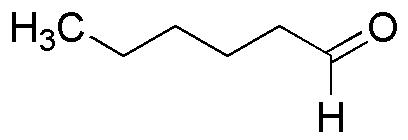Hexanal is widely utilized in research focused on:
- Flavor and Fragrance Industry: Hexanal is commonly used as a flavoring agent in food products and beverages, providing a fresh, green, and fruity aroma. Its natural occurrence in various fruits makes it a popular choice for enhancing flavors.
- Cosmetic Formulations: This compound is incorporated into cosmetic products for its pleasant scent and potential skin benefits. It can enhance the sensory experience of lotions and creams, making them more appealing to consumers.
- Agricultural Applications: Hexanal serves as a natural pesticide and plant growth enhancer. Its application can help in protecting crops from pests while promoting healthier plant growth, making it valuable for sustainable agriculture.
- Chemical Synthesis: In organic chemistry, hexanal is a key intermediate in the synthesis of various chemicals, including pharmaceuticals and agrochemicals. Its reactivity allows for the creation of more complex molecules.
- Research in Environmental Science: Hexanal is studied for its role in atmospheric chemistry and its impact on air quality. Understanding its behavior can help in developing strategies to mitigate pollution and improve environmental health.
General Information
Properties
Safety and Regulations
Applications
Hexanal is widely utilized in research focused on:
- Flavor and Fragrance Industry: Hexanal is commonly used as a flavoring agent in food products and beverages, providing a fresh, green, and fruity aroma. Its natural occurrence in various fruits makes it a popular choice for enhancing flavors.
- Cosmetic Formulations: This compound is incorporated into cosmetic products for its pleasant scent and potential skin benefits. It can enhance the sensory experience of lotions and creams, making them more appealing to consumers.
- Agricultural Applications: Hexanal serves as a natural pesticide and plant growth enhancer. Its application can help in protecting crops from pests while promoting healthier plant growth, making it valuable for sustainable agriculture.
- Chemical Synthesis: In organic chemistry, hexanal is a key intermediate in the synthesis of various chemicals, including pharmaceuticals and agrochemicals. Its reactivity allows for the creation of more complex molecules.
- Research in Environmental Science: Hexanal is studied for its role in atmospheric chemistry and its impact on air quality. Understanding its behavior can help in developing strategies to mitigate pollution and improve environmental health.
Documents
Safety Data Sheets (SDS)
The SDS provides comprehensive safety information on handling, storage, and disposal of the product.
Product Specification (PS)
The PS provides a comprehensive breakdown of the product’s properties, including chemical composition, physical state, purity, and storage requirements. It also details acceptable quality ranges and the product's intended applications.
Certificates of Analysis (COA)
Search for Certificates of Analysis (COA) by entering the products Lot Number. Lot and Batch Numbers can be found on a product’s label following the words ‘Lot’ or ‘Batch’.
*Catalog Number
*Lot Number
Certificates Of Origin (COO)
This COO confirms the country where the product was manufactured, and also details the materials and components used in it and whether it is derived from natural, synthetic, or other specific sources. This certificate may be required for customs, trade, and regulatory compliance.
*Catalog Number
*Lot Number
Safety Data Sheets (SDS)
The SDS provides comprehensive safety information on handling, storage, and disposal of the product.
DownloadProduct Specification (PS)
The PS provides a comprehensive breakdown of the product’s properties, including chemical composition, physical state, purity, and storage requirements. It also details acceptable quality ranges and the product's intended applications.
DownloadCertificates of Analysis (COA)
Search for Certificates of Analysis (COA) by entering the products Lot Number. Lot and Batch Numbers can be found on a product’s label following the words ‘Lot’ or ‘Batch’.
*Catalog Number
*Lot Number
Certificates Of Origin (COO)
This COO confirms the country where the product was manufactured, and also details the materials and components used in it and whether it is derived from natural, synthetic, or other specific sources. This certificate may be required for customs, trade, and regulatory compliance.

